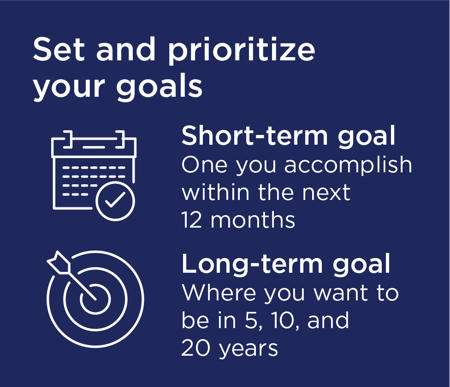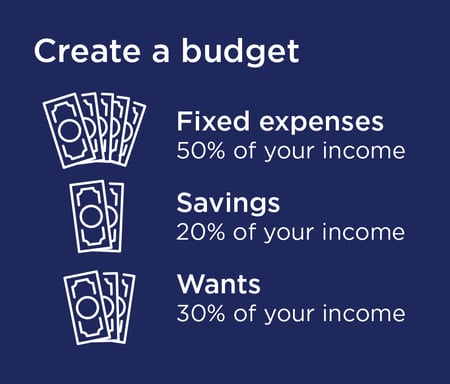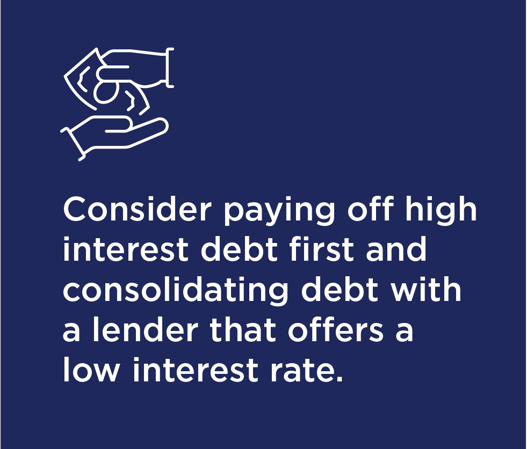Do you feel overwhelmed when you think about your financial future? If so, you're not alone. Many Canadians aren't sure how to manage their finances in a way that will support them long-term.
Here, we've compiled five simple steps you can take to help you feel better about your financial health.
Step 1: Create SMART financial goals
- Specific
- Get real about what you want. Don't just make your goals about eventually buying a home, or fully owning your car one day. Be as specific as possible with what you want your financial health to look like.
- Measurable
- "Save $50 each week" is far easier to measure than "Save more money." When your goals are measurable, you are easily able to tell whether you're staying on track.
- Attainable
- If your goals aren't realistic for your current situation, it will be tough to stay on track long-term. It's ok to start small–as you check off small goals, you'll be able to come back and make new, larger goals to contribute to your financial wellness.
- Relevant
- Are your goals smart for your current financial situation? Talking with a financial planner can help you understand whether you're making the financial wellness moves that you need to help you soar toward your goals.
- Time-bound
- Setting a deadline for your goal can help you move forward in your financial wellness. If you need to come back and adjust your deadline once you get moving, no worries. The important thing is just to have a deadline in the first place.
You'll also want to create both short- and long-term goals. Short-term goals should be set in the coming year and may be steps that lead up toward a long-term goal. A long-term goal typically takes longer than a year and requires time and planning.

Step 2: Create a budget
Time to put pen to paper and develop a budget that can help you get a grasp on your finances each month.
Your expenses will fall into three categories:
- Fixed expenses: These bills usually take up about half of your income, and include your rent or mortgage, credit card payments, utilities, food, insurance, and transportation.
- Savings: It is smart to put at least 20% of your income toward savings. Your savings does not have to just be an emergency fund–it can be an account that will eventually be used for a down payment on a house, retirement, your child's university tuition, etc.
- Wants: You'll want to keep this to 30% of your budget or less. Vacations, entertainment, and dinners out all fall into this category.
Use the percentages listed above as a general guideline. Sometimes, you may want to save more and spend less, depending on your budgetary needs.

Step 3: Say goodbye to bad debt
Yes – there's a difference between good debt and bad debt. If you have credit card debt, work to pay it off. You may want to reach out to your creditor directly to discuss the possibility of lowering your interest rate or lowering your monthly payment until you get back on your feet. While it can be tempting to apply for buy-now-pay-later programs at your favorite stores, these often come with high interest rates and can be difficult to pay off. Mortgage and student loan debt don't fall into the "bad" debt category.

Step 4: Build your emergency fund and long-term savings accounts
It is a good idea to save at least six months worth of expenses, in case you or a family member lose your job or experience another financial hardship. It is also smart to set some money aside for unexpected home or car repairs (this money should be separate from your emergency fund, as your emergency fund is meant to support you during difficult life-changing circumstances).
You will also want to think about the long-term things that you want in life, such as owning a home or retiring early, and build your financial wellness plan to reflect those goals.
Step 5: Pay down good debt
Even the good debt has got to go when you're working to improve your financial wellness. Paying more than the minimum required amount each month on debt like car loans, student loans, and your mortgage can help you sock away valuable cash that can be used for your emergency fund or for long-term savings. If you come into unexpected money (through a bonus at work, an unexpected raise, etc.), consider funneling this money directly toward paying off your good debt (assuming you have already paid off any bad debt).
Start now.
Taking care of your financial wellness is important to your overall well-being. If you are looking for help in planning your retirement and overall financial wellness, you don't have to figure it out alone. Reach out to People Corporation today to learn more about how we can help.


